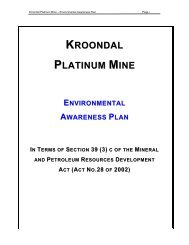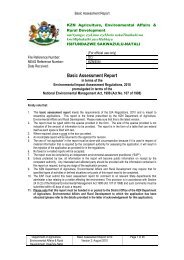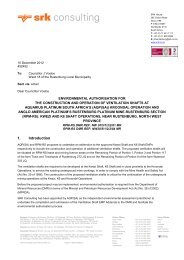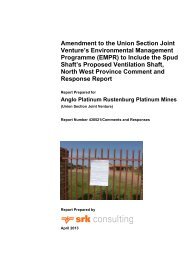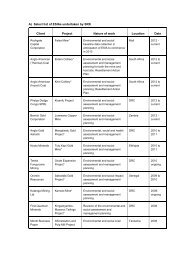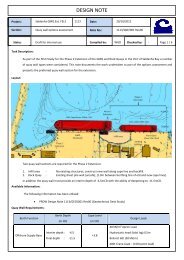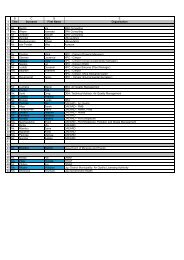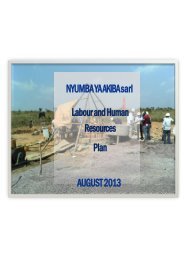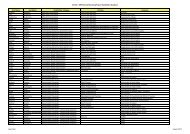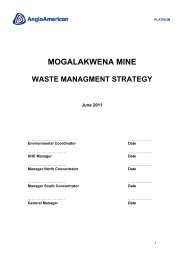Table of Contents - SRK Consulting
Table of Contents - SRK Consulting
Table of Contents - SRK Consulting
Create successful ePaper yourself
Turn your PDF publications into a flip-book with our unique Google optimized e-Paper software.
Limpopo West Mine: Biodiversity and Impact AssessmentSPECIES COMMON NAME LoO STATUS (OTHER)Myotis tricolor Temminck's hairy bat 3 -Parahyaena brunne Brown hyaena 1 PS*, PWACrocuta crocuta Spotted hyaena 5 PS*Leptailurus serval Serval 2 PWAMellivora capensis Honey badger 1 PS*, PWALeast Concern - Protected SpeciesPanthera pardus Leopard 2 VU*, PWAFelis nigripes Black-footed cat 3 VU**, PSVulpes chama Cape fox 2 PSCeratotherium simum White rhinoceros 1 PS*, NT**, SPWARaphicerus campestris Steenbok 1 PWARedunca arundinum Southern reedbuck 3 PWARedunca fulvorufula Mountain reedbuck 3 PWAConnochaetes gnou Black wildebeest 5 PS*Syncerus caffer African buffalo 1 PWAOtocyon megalotis Bat-eared fox 2 PWAFelis silvestris African wild cat 1 PWAGalago moholi South African galago 2 PWAGiraffa camelopardalis Giraffe 1 PWAHippopotamus amphibious Hippopotamus 5 PWAProteles cristatus Aardwolf 2 PWAPronolagus randensis Jameson's red rock rabbit 4 PWACivettictis civetta African civet 1 PWA7.2.9. BirdsA list <strong>of</strong> the 20 conservation important (CI) bird species considered likely to occur based onSABAP data and / or prior NSS observations within the area are classified in <strong>Table</strong> 7-36according to their South African Red List status as presented in Barnes (2000). TheirNEMBA (2007) and LEDET (2003a) protection status has also been included.Three conservation important bird species have been detected within the mine area whichincludes one Vulnerable species one Near-threatened species and one conservationimportant Least Concern Species. White-backed Vulture (Gyps africanus) – Vulnerable: White-backed Vultures aregenerally associated with dry woodland and tall trees, which they are dependant uponfor breeding. Birds were recorded soaring above the study area and feeding within it.However no evidence <strong>of</strong> breeding activity was immediately apparent on site. The totalpopulation is estimated at less than 10000 idividuals and is in decline. The mostsignificant cause <strong>of</strong> this decline being a loss <strong>of</strong> habitat and decreased foodavailability. Collision, electrocution, poisoning and drowning also threaten thisspecies. Red-billed Oxpecker (Buphagus erythrorhynchus) – Near-Threatened: althoughformely widespride these birds suffered local population declines particularly in theEatern Cape and Pilanesberg National Park as a result <strong>of</strong> hunting <strong>of</strong> game and theuse <strong>of</strong> arsenic-based ‘purple lable’ cattle dips which poisoned both ticks andoxpeckers. More recently ongoing re-introductions and the use <strong>of</strong> oxpecker friendlygreen-label dips together with the oxpecker’s adaptability to feed on domesticlivestock are bringing them back from localised extinctions99



